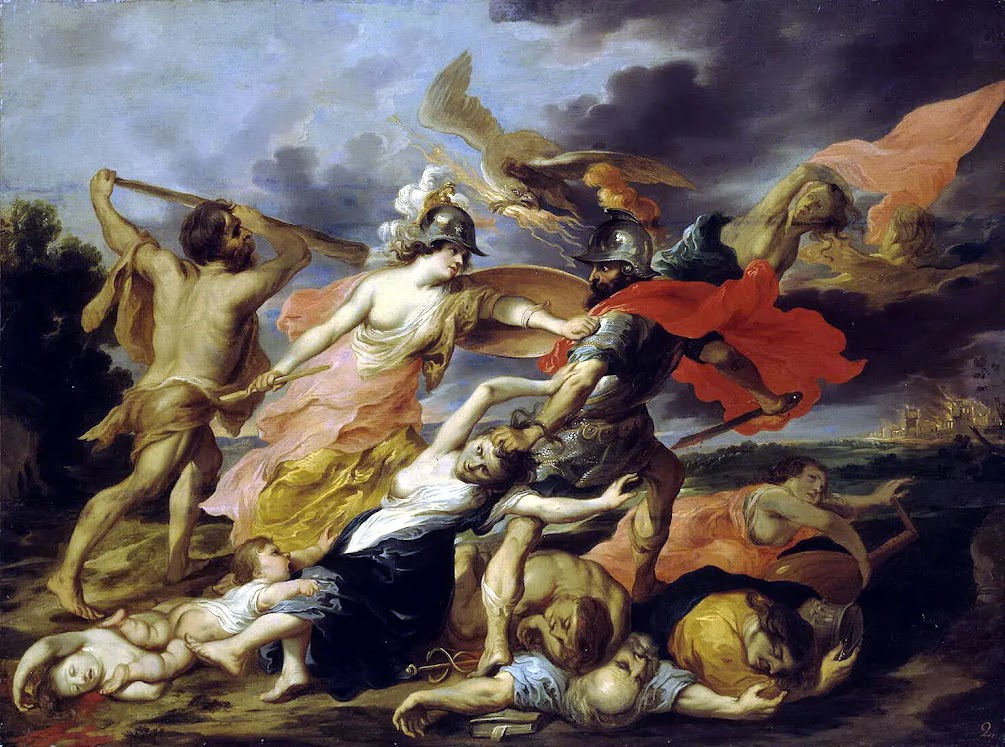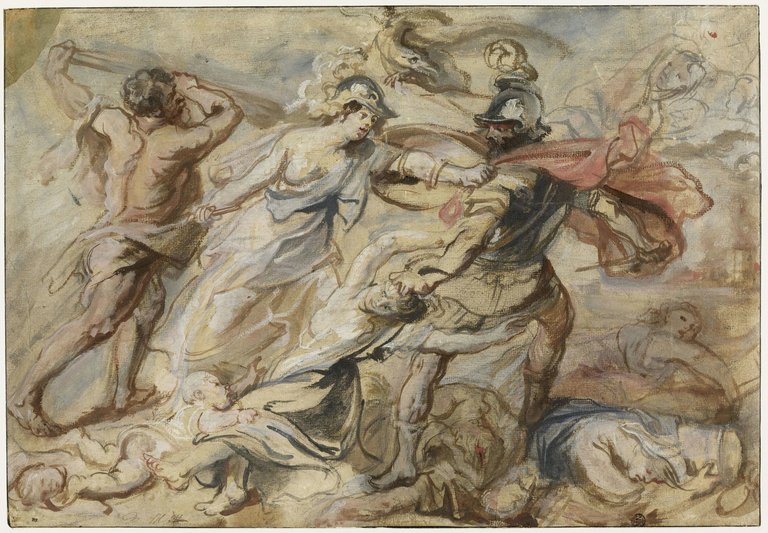Wolfoet, Victor II (1612-1652)
Allegory of War, c. 1630s - 1640s
Oil on canvas
67x89 cm
Minerva, protector of peace, assisted by Hercules, does not hesitate to throw herself against Mars, the god of war ready to massacre a woman with her child, under the gaze of Jupiter on his eagle. In the freedom of treatment and the science of movement we find the genius of an erudite and inventive artist for whom mythological allusions had no secrets' Catherine Loisel
Victor Wolfvoet (II) or Victor Wolfvoet the Younger (1612 – 1652), was a Flemish art dealer and painter of history and allegorical paintings. His artistic output was heavily influenced by Peter Paul Ruben
Wolfvoet the Younger was born in Antwerp as the son of Victor Wolfvoet the Elder, a painter and art dealer. His father was probably his teacher. He became a member of the Antwerp Guild of Saint Luke around 1644-5. Some sources refer to Wolfvoet as a pupil of Rubens.
He married in 1636. His 1652 will, which he made not long before his death, states that he was the widower of Elisabeth Mertens. Victor Wolfvoet died in Antwerp on 23 October 1652 leaving one daughter, Livina Wolfvoet.
The artist's estate comprised a substantial collection of artworks of seven hundred items. The inventory of his estate lists twenty sketches by Rubens, including several designs for the ceilings of the Carolus Borromeus Church in Antwerp and six bozzetti for the Triumph of the Eucharist tapestry series. There are also sketches by other artists, many unattributed sketches and framed grisailles, and a number of sketches after Rubens. Some of the sketches were likely in Wolfvoet's own hand, like his copies after Rubens' Abraham and Melchizedek and Manna from Heaven both now in the Mauritshuis, The Hague. The large collection of works has been regarded as evidence that the artist may also have been active as an art dealer. More on Victor Wolfvoet (II)
Peter Paul Rubens
Hercules and Minerva Fighting Mars, ca. 1632-35
Gouache and brush and brown ink over preliminary drawing in black chalk, on light brown paper
370 x 537 mm
Département des Arts Graphiques du Musée du Louvre, Paris
'In 1630 Rubens offered King Charles I of England the painting representing 'War and Peace' or 'Minerva fighting against Mars'. This work in some way celebrated the diplomatic negotiations in which the artist had participated to avoid a war between Spain, England and France in previous years.
Sir Peter Paul Rubens (28 June 1577 – 30 May 1640) was a Flemish Baroque painter. A proponent of an extravagant Baroque style that emphasized movement, colour, and sensuality, Rubens is well known for his Counter-Reformation altarpieces, portraits, landscapes, and history paintings of mythological and allegorical subjects.
In addition to running a large studio in Antwerp that produced paintings popular with nobility and art collectors throughout Europe, Rubens was a classically educated humanist scholar and diplomat who was knighted by both Philip IV of Spain and Charles I of England. More Sir Peter Paul Rubens
Please visit my other blogs: Art Collector, Mythology, Marine Art, Portrait of a Lady, The Orientalist, Art of the Nude and The Canals of Venice, Middle East Artists, 365 Saints, 365 Days, and Biblical Icons, also visit my Boards on Pinterest
Images are copyright of their respective owners, assignees or others. Some Images may be subject to copyright
I don't own any of these images - credit is always given when due unless it is unknown to me. if I post your images without your permission, please tell me.
I do not sell art, art prints, framed posters or reproductions. Ads are shown only to compensate the hosting expenses.
If you enjoyed this post, please share with friends and family.
Thank you for visiting my blog and also for liking its posts and pages.
Please note that the content of this post primarily consists of articles available from Wikipedia or other free sources online.





No comments:
Post a Comment